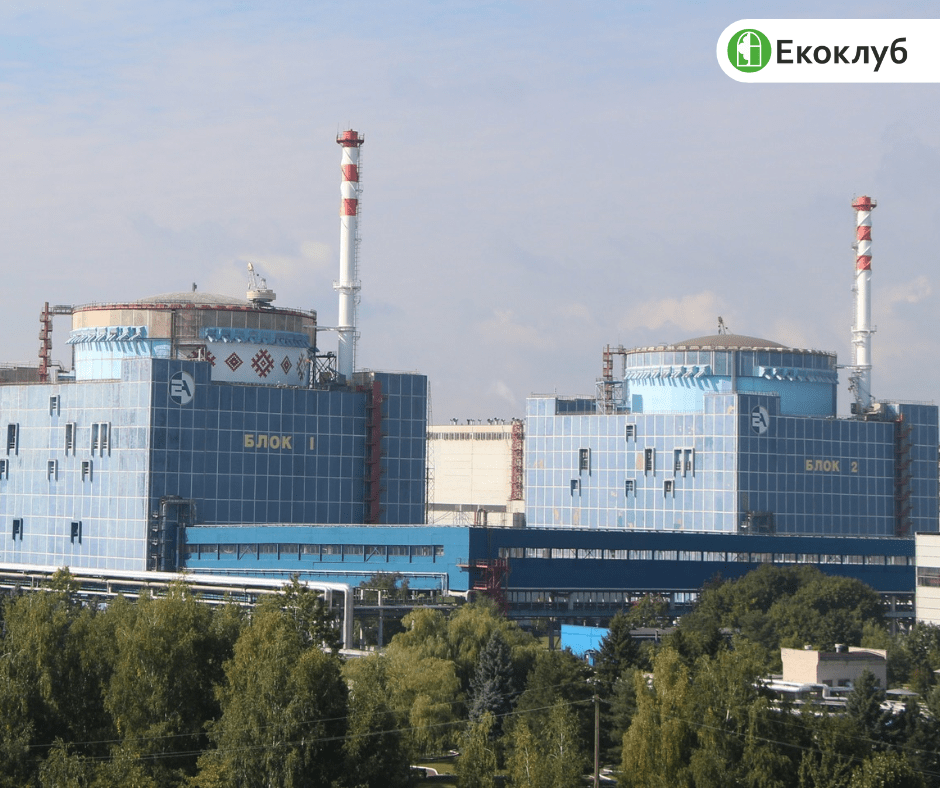The plans for constructing new nuclear power units of the state-owned enterprise (SE) “Energoatom” are growing rapidly due to the need for electricity in Ukraine. However, how soon will nuclear electricity from new units become available to Ukrainians? What environmental and climate threats will the construction plans have without preliminary studies? And who will pay for their construction? How will potential construction affect Ukrainians and the environment of the region?
What is the problem?
As part of the post-war reconstruction plan, the Economic Development Committee plans the achievement of energy independence through the development of nuclear energy. The plan states: it will take three to five years to achieve such a result. However, only the construction of new nuclear power units will last at least one decade.
Non-governmental organisations “Ekodiya” and “Ekoklub” believe that decisions on plans to build new power units are impractical and will have negative consequences. Is it worth investing in nuclear energy in the context of an unfinished war, post-war reconstruction, and climate change?
In the summer of 2022, the SE “Energoatom” and the American company Westinghouse Electric Company signed an agreement. According to it, nine new nuclear power units using AP1000 technology will be built in Ukraine. Six AP1000 units are planned to be built: units No.5 and No.6 of the Khmelnytsky nuclear power plant, one each at the sites of the South Ukrainian and the Rivne nuclear power plants, and two more at new sites: near the cities of Chyhyryn and Teplodar.
The danger to the environment
Potential deficit of water resources
Ukrainian nuclear power plants (NPP) have repeatedly faced the problem of lack of water for reactor cooling. Fresh water is used for their cooling. Most regions of Ukraine are poorly provided with water resources: 0.14-0.72 thousand m3/year per person. In Europe, the average figure per person is 4.56 thousand m3/year.
In 2015, only one out of two turbines worked at the Rivne NPP for more than half a year due to drought and shallowing of rivers by two meters. Reducing the capacity of the Rivne NPP was also discussed in 2018 for similar reasons. The station is cooled by the Styr River, which is shallowing due to climate change.
In 2016 and 2017, additional water was pumped in from the Horyn River to cool two power units at the Khmelnytskyi NPP. Despite this, two additional units are planned to be built at the Khmelnytskyi NPP. This will affect the ecosystem of the river.
In the southern, more arid part of Ukraine, there are nine nuclear power units: six at Zaporizhia and three more at the South Ukrainian nuclear power plant. Completion of a new unit at the South Ukrainian nuclear power plant and construction at the Chyhyrinsk station (located higher up the Dnipro River than the mentioned NPPs) may cause an even greater shortage of water in the southern, partly eastern regions of Ukraine and Crimea.
Climate change
According to the 2021 Analysis of the Impact of Climate Change on Ukraine’s Water Resources, most river basins will experience a decrease in average annual flow this century. It is necessary to consider possible water shortages in the case of designing and building new nuclear power plants.
The average annual temperature in Ukraine is projected to increase by 0.8-1.1°C. The redistribution of precipitation throughout the year will also increase there will be more precipitation in the cold season, and less in the warm months, when the need for NPP cooling increases.
Security factor
Safe construction by AP1000 technology
Westinghouse Electric Company claims that due to simplified systems, AP 1000 reactors are cheaper to build, operate, and maintain (due to lower piping safety, fewer cables and pumps, and a smaller overall building area). However, according to the U.S. Nuclear Regulatory Commission’s report on the safety assessment of the AP 1000 reactor, the reactor shield would not withstand a direct hit from an airplane.
Economic factors
Risk of spending finances and long-term construction risks
According to the NGO Ecodiya, the American company Westinghouse Electric Company is not a reliable partner in the construction of new reactors. In the past, the company has implemented four projects using this AP 1000 technology, each with two reactors: some in the United States and some in China.
Both American projects Alvin W. Vogtle Electric Generating Plant, Georgia, and VC Summer, South Carolina, were delayed from the beginning. Construction in both cities began in 2013. However, in 2017, the construction of Virgil C. Summer Nuclear Generating Station was estimated to be completed in 2024, and therefore canceled. The preliminary cost of the project was $9.8 billion in 2017, which increased to $25 billion.
This year, the first reactor (Unit 3) was launched in Alvin W. Vogtle Electric Generating Plant with a six-year delay, and the second reactor (Unit 4) is being prepared for launch. Currently, the project cost is estimated to be $30 billion, although, at the start of construction, this amount increased to $14 billion.
In Ukraine, the average cost of building one power unit using AP 1000 technology is currently estimated at five billion dollars.
Construction financing
The construction NPP in Ukraine is planned to be financed by Energoatom and loans from Westinghouse Electric Company in the United States.
The construction of both American projects was funded by final consumers. However, while the Vogtle power plant started operating this year, consumers living near the unfinished plant of Virgil C. Summer continue to pay for the service they did not receive to compensate for the construction credit.
According to Oleksiy Pasyuk, a representative of CEE Bankwatch, development banks do not finance the construction of new nuclear reactors. Accordingly, private foreign investors will be involved in the construction of new nuclear power units. Otherwise, the financing will be the responsibility of Ukrainian taxpayers.
For note: The cost of rebuilding Mariupol is estimated at $14 billion, which is half the cost of the Alvin W. Vogtle Electric Generating Plant project.
The cost of 1 MWh produced at NPP
The calculated cost of 1 MWh produced in the newly built reactors in Vogtle is on average $150 for Georgia Power customers. At the same time, energy from solar plants can cost about $30 per MWh.
Despite the plans to build six new nuclear power units, in April 2023, Energoatom signed a new agreement with Holtec International to build 20 more nuclear power units with SMR-160 reactors.
We are worried about such a tempo of planning the construction of new nuclear power units without a proper study of the availability of water resources and the financial viability of projects in the post-war economy of Ukraine.
“Will not we face a choice: to cool the reactor or to provide fresh water to people and agriculture, will there be enough water for all consumers, including natural areas? The country’s energy security must be ensured, but peaceful nuclear power is not the safest, most financially appropriate, or quickest solution,”
– says Olha Liashchuk, project coordinator of the Ecoclub.
Before the possible construction of new nuclear reactors, it is necessary to perform a study of the sufficiency of water resources and the impact on other infrastructure. It is also essential to take into consideration climate change forecasts in each of the regions where construction is planned (an increase in CO2 emissions and average annual temperature, atypical weather changes during seasons such as droughts or floods, changes in air and water quality, etc.)
Given the above arguments, we urge you to sign the petition to stop the construction of new nuclear power units.
This article was written as part of the project “Closing the Cycle: A Just Energy Transition Designed by Cities and Regions” funded by the European Union and the project “Building the Ecofeminist Movement” with the support of WECF International.












